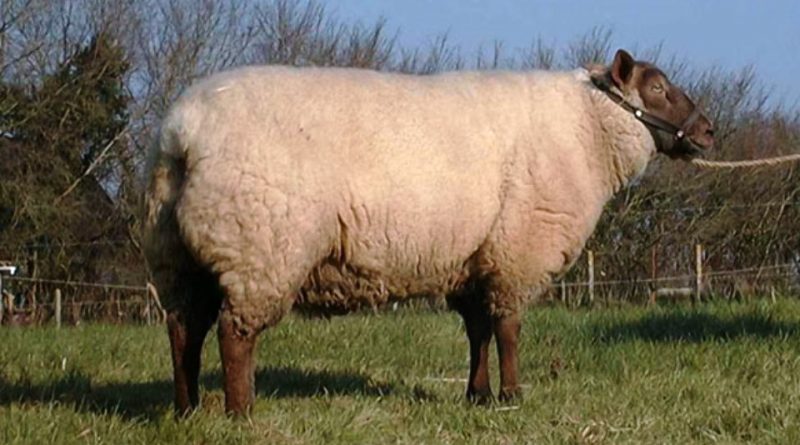Roussin de la Hague
Roussin de la Hague
The Roussin de la Hague sheep breed is a sheep (Ovis aries Linnaeus, 1758) originating from northern France, with a main aptitude for meat production.
Systematic –
From a systematic point of view it belongs to:
Eukaryota domain,
Kingdom Animalia,
Phylum Chordata,
Mammalia class,
Order Artiodactyla,
Suborder Ruminantia,
Bovidae family,
Subfamily Caprinae,
Genus Ovis,
Species O. aries,
Roussin de la Hague breed.
Geographical and Areal Distribution –
The Roussin de la Hague is a very ancient French sheep breed, originating from northern France. Its place of origin is located in the north-west of the Manche department, in the La Hague region. Its presence has been attested since the 18th century, then it was the subject of various crosses with Anglo-Saxon breeds, but it was not until 1982 that it was officially recognised.
This breed is mainly found in its original cradle, in the north of the Channel, where 7,000 to 8,000 sheep are concentrated.
Origins and History –
The Roussin de la Hague sheep breed is a local sheep from the North of the Channel, in the Hague region, born in the 18th century from a cross between the Anglo-Norman and Ouessant breeds; it was crossed for the first time in 1920 with Dishley and South Down rams to increase the quality of its meat. 40 years later, we meet her again with Suffolks. The departmental breeding farm of the Manche organized the first checks starting in 1976 and qualified the first sheep of the breed in 1977, i.e. around 1,000 heads. In 1978 the breeders created an association to obtain official recognition from the Ministry, which they obtained in 1982.
Morphology –
The Roussin de la Hague is a large sheep, with measurements ranging from 65 to 70 cm, with weights from 70 to 90 kg for females, and 70 to 75 cm, with weights from 100 to 130 kg for males.
Sheep have white wool with a brown head and legs and have no horns. Their semi-long white fleece covers neither the head nor the legs
Its forehead is free of wool and the muzzle is slightly concave and linear.
It has lively eyes and ears that are erect and set rather high.
Productive attitude –
The Roussin de la Hague sheep breed is a precocious and rustic sheep; it is undemanding, particularly suitable for the humid and windy climate of the Atlantic coast. It can exploit rather poor soil and is, for example, bred as salt lamb, but it is on the rich pastures of the Cotentin that it can exploit its maximum potential.
It adapts well to the winds and climate of the English Channel coasts and its prairies, where it still lives mainly today.
It is an easy sheep to raise thanks to its calm and docile temperament and its ability to be content with a moderate diet. It offers high reproductive performance, with a good value of the mothers’ milk, which allows the lambs to have variable growth between 240 and 305 g/day between 10 and 30 days. They are also very maternal and raise their young well. Births generally occur without difficulty. It is an early breed, with 61% of females giving birth before 15 months. It also has a fair prolificacy which is on average 175%. The lambs have a good growth capacity and their white and consistent fat is appreciated by connoisseurs.
The Roussin de la Hague breed is generally raised in small flocks, with fewer than 50 sheep per flock. Lambing takes place in winter. The lambs produced are light; they are generally grass-fed. They are marketed with a carcass weight of around 17-18kg and these lambs remain renowned in their region of origin. It can be bred as a pure breed, but also by crossing it with meat breeds, in order to produce lambs with better conformation and more suitable for the market.
The breed selection system was adopted in 2003 by a breeding center located in Gréville-The Hague. This center has long been primarily interested in preserving genetic variability within the breed, which remains threatened due to its limited numbers, and in working on resistance to scrapie in sheep. Now that these two objectives have been largely achieved, the breeding center will allow us to work on increasing the animals’ performance. The selection base, however, remains limited, with just 2,000 sheep subjected to performance checks.
The lambs, which live well both in poor areas and on rich pastures, are enhanced by the PDO “Prés-Salés du Mont Saint-Michel”.
Additionally the breed is celebrated in August at an annual show in Jobourg, with a dedicated breeding center in Tonneville, supported by the Channel General Council.
Guido Bissanti
Sources-
– Wikipedia, the free encyclopedia.
– Balasini Dialma, 2001. Applied zootechnics. Sheep and goats. Sheep and goats. For technical and professional institutes, Caledrini Edagricole, Bologna.
– Daniele Bigi, Alessio Zanon, 2010. Atlas of native breeds. Cattle, horses, sheep, goats, pigs raised in Italy, Edagricole-New Business Media, Bologna.
Photo source:
– https://www.racesdefrance.fr/races/98-les-races-ovines/les-races-ovines-en-conservation/145-race-ovine-roussin-de-la-hague

